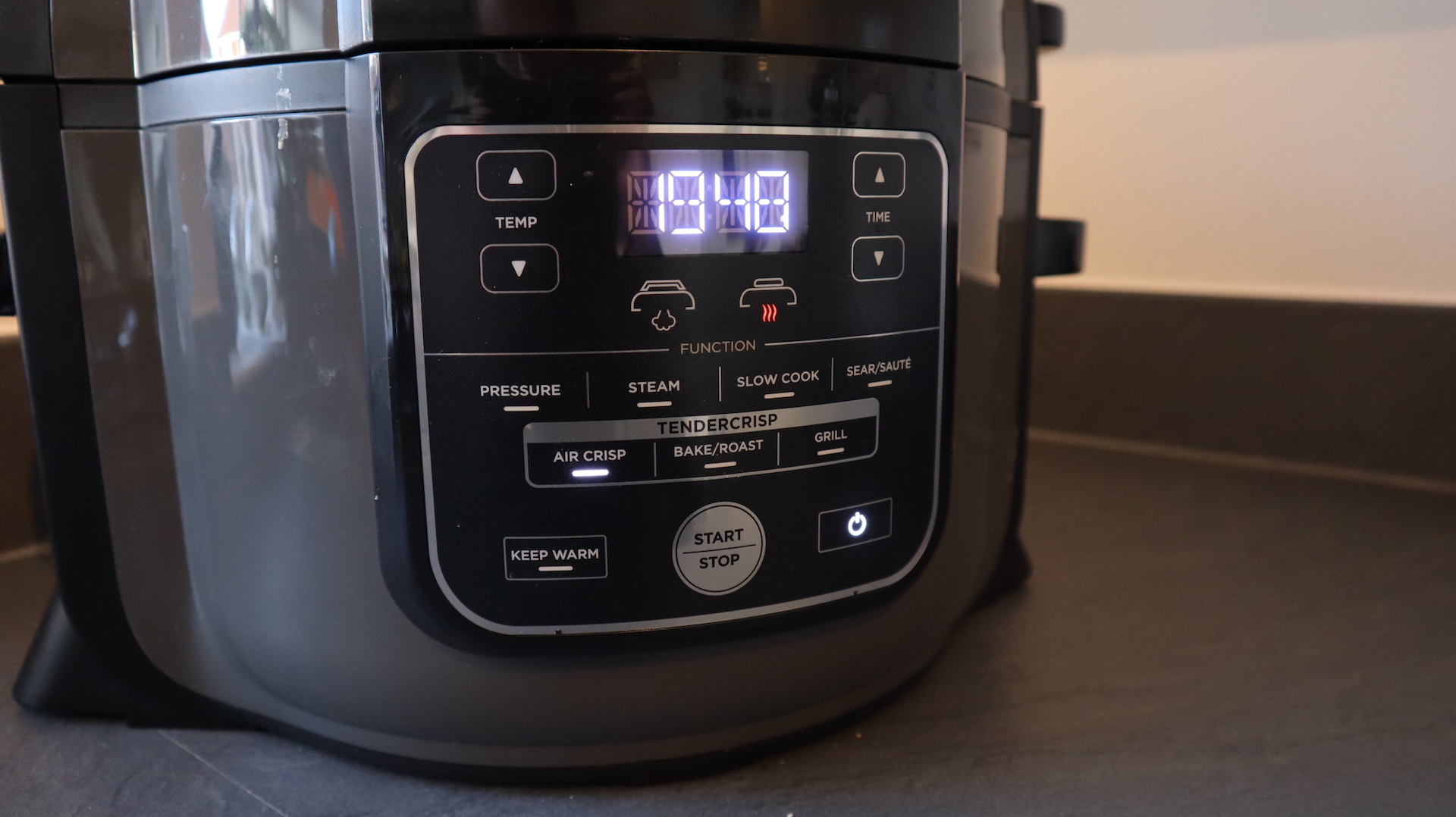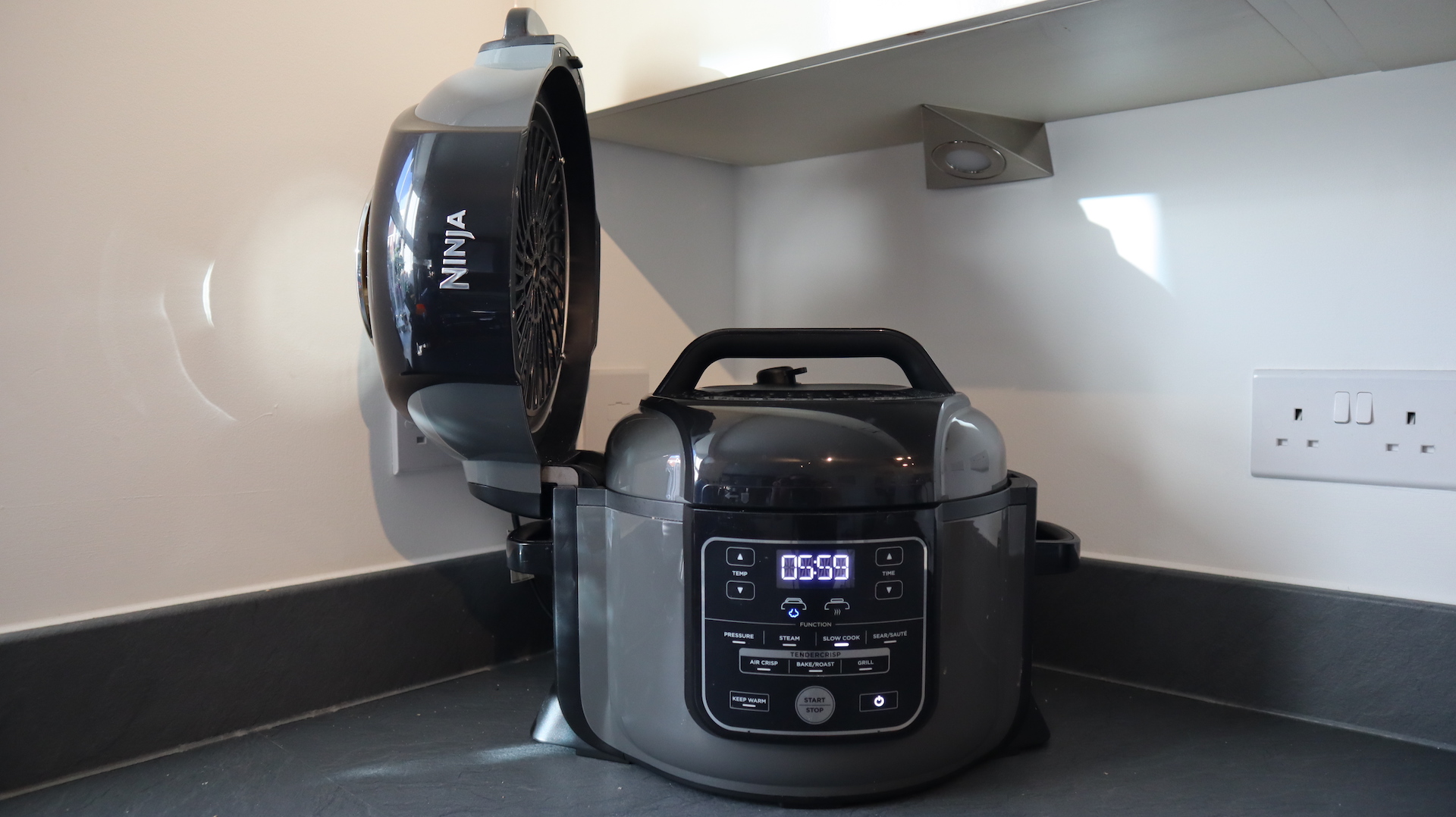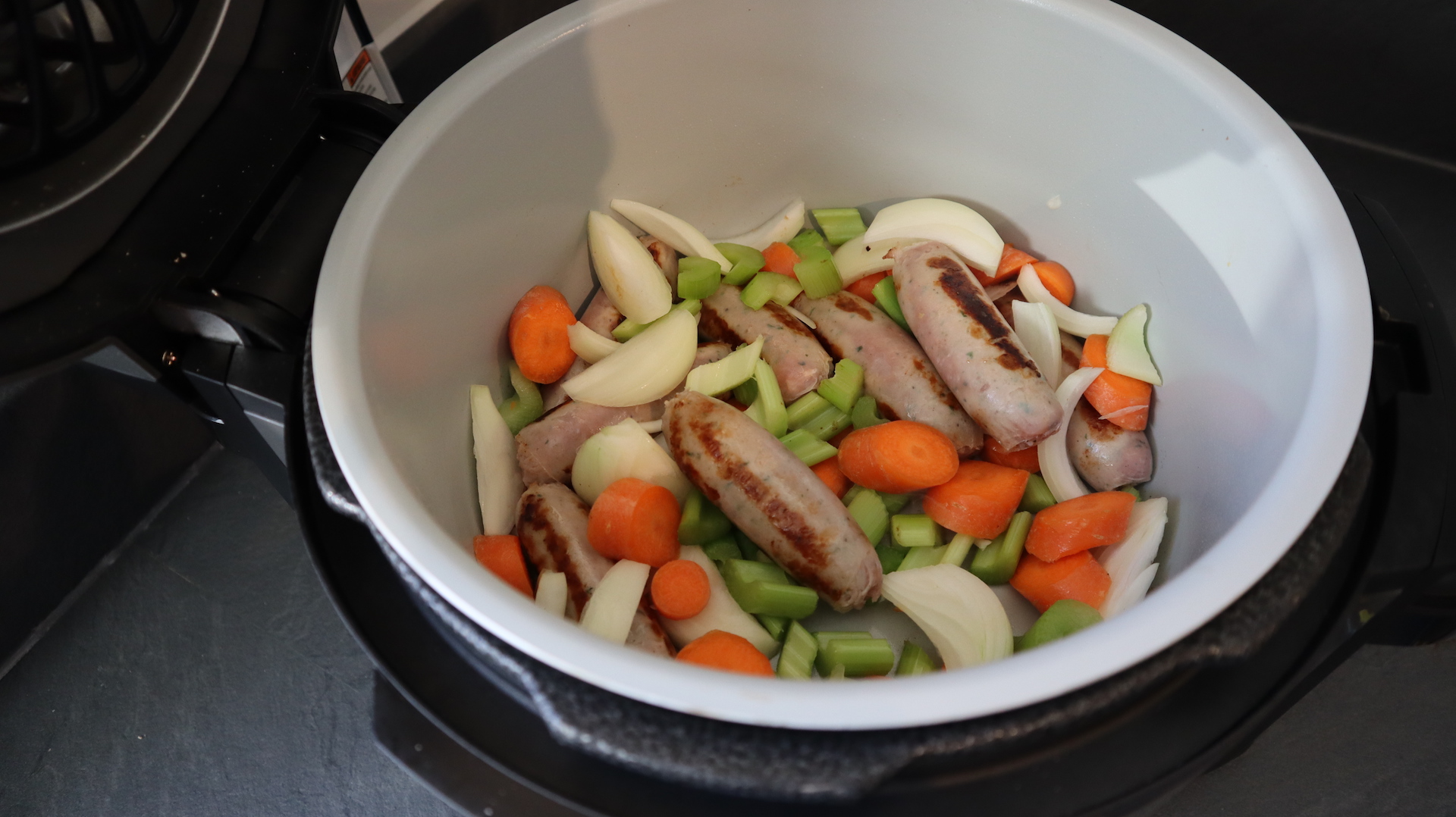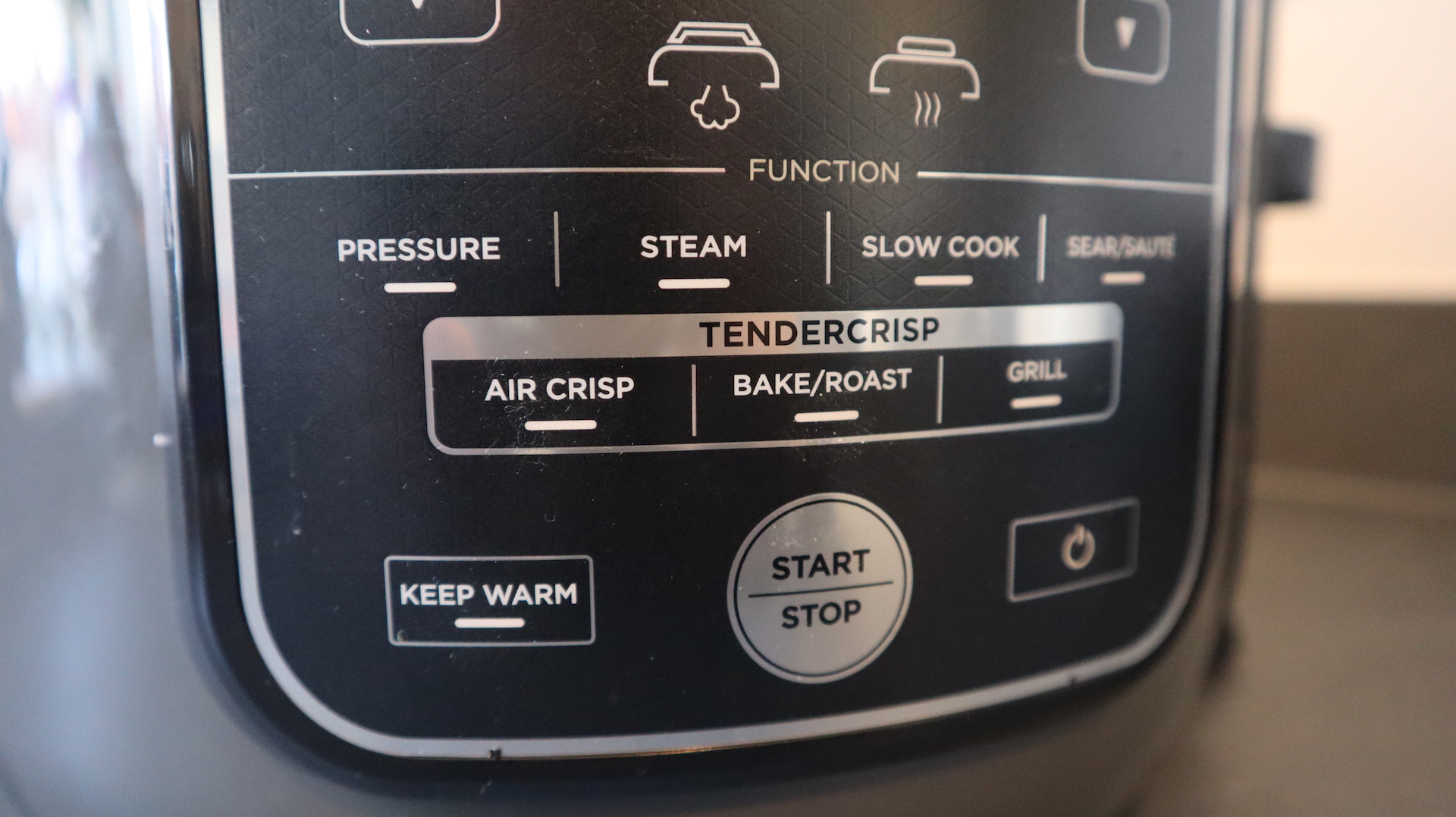TechRadar Verdict
If money is no object and space is abundant, the Ninja Foodi Multi-Cooker is a fantastic investment with a wide variety of options. If you can stand its industrial design, that is...
Pros
- +
Highly versatile appliance
- +
Large capacity
- +
Range of settings
Cons
- -
Complicated to use
- -
Expensive
- -
Ugly
Why you can trust TechRadar
Aside from throwing stars and stealth assassinations, the word 'Ninja' these days is probably best known as the name of the kitchen appliance brand and its range of “bullet” blenders, designed for making juices and smoothies. But the Ninja Kitchen brand makes a variety of appliances including its all-singing, all-dancing Ninja Foodi Multi-Cooker.
The Ninja Foodi offers eight settings, from air frying to baking, roasting, sauteéing, grilling, slow cooking, pressure cooking and a keep-warm function in a single machine. In fact, it's one of the best Instant Pot alternatives on the market.
Due to the fact it covers so many bases, the Ninja Foodi has a large 6L pot, with a 3.2L removable frying basket, as well as a grilling rack and two lids - one fitted with a vent for pressure and slow cooking, and the other for everything else. It additionally has an hour-long timer and offers the highest temperature of any air fryer we’ve tested, at 210° Celsius.
It is, however, also one of the more expensive multi-cookers on the market, making it a harder sell than some of its competition.
Price and availability
The Ninja Foodi Multi-Cooker is available now, priced with an RRP of £199 / $249 – though it's also regularly discounted, with an Amazon Prime Day offer knocking $100 off that price in the US in the summer of 2019.
On the face of things, with its expansive feature set, that price tag looks reasonable. But do note that there are many similar products on the market that offer similar feature sets at lower price tags. The Instant Pot Duo V2, for instance, may lack the air-frying function, but covers off many of the other features, at a much lower price point.
Design
As you’d expect from an appliance that is effectively a mini oven, the Ninja Foodi is a monster of a machine taking up a significant chunk of space on a worktop and looking industrial (read: ugly) with its grey and black design.

Its bulky lid opens to the side on a hinge meaning it can’t be fully opened while tucked underneath a kitchen cupboard and this, coupled with its overall size, makes it nigh-on impossible to comfortably fit anywhere where space is at a premium.
Settings are controlled via a panel on the front situated below a digital display. The time and temperature controls sit either side of this display. During cooking, the time ticks down on this screen which gives you an at-a-glance way to keep track of timings.
Below the display is your choice of cooking options: Pressure, Steam, Slow Cook, Sear/Sauté, Air Fry, Bake/Roast and Grill. The Keep Warm button is bottom left, the On button is bottom right and a large Start/Stop button sits in the center. Although these controls are clearly labelled, they do add up to quite a complex machine and as there are no pre-programmed settings, like you find on many other air fryers for example. Every task requires you to manually select the cooking type, time and temperature, and this all takes a little getting used to.
A major plus to having such a variety of settings, and the fact it’s such an imposing machine, is that it’s perfect for feeding large families and party guests. It offers a huge capacity, unprecedented versatility and it’s also, surprisingly, quiet.

Performance
Over the course of two months, we put each of the Ninja Foodi’s settings through their paces, from air frying chips and chicken to baking cakes and roasting potatoes; from making a slow-cooked sausage stew and Chilli Con Carne, to steaming vegetables and pressure-cooking risotto.
Airfrying
When it came to air frying chicken, the Ninja Foodi did a stand-up job. The skin was crispy and the meat was succulent. When it came to air frying chips, however, the Ninja Foodi’s performance fell short. Manually setting the Foodi on the same temperature and for the same time as we cook homemade chips in our fan oven, we were disappointed when they came out overcooked. The skin was too crispy, almost rock-hard, while very little potato was left on the inside. We’ve since experimented with these settings and while the results have been better, they don’t match up to the way the Foodi cooked the chicken, or the way most of the Ninja Foodi’s air fryer rivals cook chips.
Baking/roasting
During our tests, we twice roasted potatoes using the Bake/Roast function. Once from frozen, using shop-bought roasties, and once from scratch using fresh potatoes. Unlike its disappointing performance when air frying chips, both batches of potatoes were delicious. The smaller batch of the frozen potatoes, given the fact their skins are pre-cooked, bordered slightly on being overly crispy, but the batch generally had fluffy centers inside crunchy cases. Meanwhile, the fresh potatoes were the best homemade roast potatoes we’ve ever made with a perfect combination of taste and texture. Not something we say lightly.

Using the same Bake/Roast function, we used the Ninja Foodi to bake chocolate muffins on the grilling rack, followed by a fudge cake in its cooking pot. Both recipes were from packets and tasted as we expected, as they do when cooked in a regular oven.
The downside to cooking muffins this way is that there is only so much space on the grilling rack compared to a normal oven, so your batches will be smaller. The plus side for making cakes in the Foodi is that you can mix everything inside the multi-cooker’s non-stick pot before baking. No need for multiple mixing bowls, baking paper or lining tins with grease, not to mention the fact this cuts down on washing up. That said, if you need the cake to be a specific size, you could still place a cake tin with the cake mixture inside the Foodi and bake in the same way as you would in an oven.
Searing/Sauteeing and Slow Cooking
Onto searing, and slow cooking. Many recipes require you to fry ingredients, such as onions for curries or chunks of beef for stews, in a frying pan before placing them in a slow cooker. Not the Ninja Foodi. You can switch from searing or sauteéing food to slow cooking at the touch of a button. Simply add the rest of your ingredients, hit Slow Cook and select your cooking time. It is true you can effectively “fry” ingredients in regular slow cookers but they never get hot enough to really achieve that desired caramelised color and if you’re a slow-cooker fan, this particular Ninja Foodi feature is a game changer.
Once the slow cooking timer ends, the Foodi’s 30-minute Keep Warm function kicks in to stop your meal from spoiling. In fact, at the end of any cooking function you can use the Keep Warm button to maintain a low, steady temperature until you’re ready to serve. If you don’t, the Ninja Foodi will simply beep and turn off. Both this Keep Warm option, and the automatic shut off feature, give the Ninja Foodi a significant edge over most regular ovens.
So far, so good.
These features give the Ninja Foodi far greater versatility, and represent greater value for money than buying separate slow cookers, air fryers and mini ovens. Having so many settings can prove confusing, especially when you’re trying to establish which setting best suits what you’re trying to cook, but on the whole if you approach most meals cooked in the Ninja Foodi in the same way you would a regular oven, it’s straightforward. What’s not straightforward, however, is pressure cooking.

Pressure cooking
If you’ve never used a pressure cooker before, it’s worth watching a video or two on how the process works. This is because it takes everything you know about cooking and throws it out of the window.
Firstly, it significantly messes with timings. A small chicken usually takes an hour and 10 minutes to cook in our oven. In the Ninja Foodi’s pressure cooker, it took just 15 minutes. That’s a fully roasted chicken in a quarter of an hour.
Similarly, cake bites that normally take 20 minutes were on the edge of being overdone in six, and a bacon and pea risotto we typically slave over for 40 minutes was done in less than 10. Ideal for meals in a hurry, less so when trying to work out how long it will take such meals to quickly become ruined.
Secondly, you need to factor in how long it takes for the Ninja Foodi’s large pot to reach the desired pressure, and then how long you need to release that pressure for at the end of cooking. If you release pressure too slowly you end up overcooking your food. Too quickly, and you run the risk of undercooking it. Recipes will advise on each of these timings but it took a fair amount of trial and error to achieve the results we wanted, plus, unless you’re using recipes written specifically for the Ninja Foodi, you’ll need to experiment.
Then there’s the additional lid. The Ninja Foodi’s standard Tendercrisp lid is permanently attached via a hinge, but its pressure cooking lid can be fitted or removed as needed. It’s not particularly difficult to use – it has arrows that help you line up where it needs to go – but it is a faff having to switch it in and out. Plus, it’s far from small so storing it is a pain.
Once we’d hit on the ideal timings of each pressure-cooked recipe, the quality of food was great and the time-saving benefits soon outweighed any hassle we’d experienced getting to that point. We’ve attempted risottos in slow cookers and pressure cookers in the past and they’ve never lived up to those we’ve made on a hob, until Ninja Foodi’s risotto. The rice tasted as if it had been given the usual amount of time to absorb the water and flavor and had a nice bite to it, without being undercooked or chalky. Similarly, given the fast cooking times, we had expected the bacon and peas to be soft and lacking in texture, but they weren’t. They both had bite and tasted fresh.

Grilling
Whereas many of the other Ninja Foodi features give your regular oven a run for its money, its grilling function does not. It’s a good addition to have, but it’s far less versatile and less effective, than using a standard grill. Firstly, because of the Foodi’s size you’ll struggle to get more than two chicken breasts comfortably on the rack. The height of the rack is also limiting. It’s not possible to place the grilled food closer, or further away from the grill element.
Steaming
The cooking option we used the least, but is worth mentioning, is the option to steam food in the Foodi. You need the grilling rack, or a similar accessory, to place the ingredients on and then steam is created by putting water beneath it. It works fine. As you’d expect but unlike with the majority of other settings, there’s nothing about steaming in the Foodi that sets it apart from traditional methods. The only point we will make is that it is an easy way to make a bain-marie.
Verdict
Given the high price tag, its industrial size and multi-purpose use, the Ninja Foodi is not for the faint hearted. Firstly, it’s far from cheap, but it does negate the need to buy a separate slow cooker, pressure cooker and air fryer. Secondly, its large size is smaller than having all three on your kitchen top. If you have the money and the space, it’s a great kitchen appliance to have in your arsenal.
Each of its functions work well on their own. Some perform better than others and some are easier to use than others, yet it’s having them all in one place that truly sets the Ninja Foodi apart from anything we’ve ever used. From roasting a chicken to being able to quickly switch to the air frying function to crisp up its skin; from being able to sear ingredients before switching to slow cooking; the Ninja Foodi has the potential to replace your regular oven. For at least the majority of meals.
Since we’ve been testing the Foodi, we’ve only used our hob a handful of times, and even then it was to make poached eggs or omelettes. We can’t remember the last time we didn’t use the Foodi for at least one element of our meals and that speaks volumes to just how great it is.
- Check out the best Instant Pot deals
- Get the best deals on Ninja products with our Ninja promo codes.

Victoria Woollaston-Webber is a freelance journalist, editor, and founder of science-led health, beauty, and grooming sites, mamabella and MBman. She has more than a decade of experience in both online and print journalism, having written about tech and gadgets since day one for national papers, magazines, and global brands. Victoria specializes in beauty gadgets, as well as small appliances including vacuum cleaners, air fryers, blenders, and mixers, plus all things baby and toddler. When she’s not testing the latest must-have beauty product, she loves Lego Architecture, murder mysteries, and chasing after her four-year-old.
